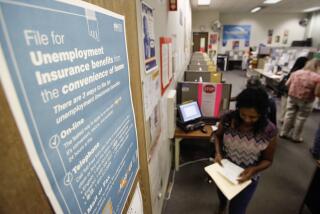State’s jobless rate surges
California’s jobless rate jumped to 6.1% in December, up from 4.8% a year earlier, prompting Gov. Arnold Schwarzenegger to move to expedite public works projects in an effort to stimulate the economy.
The surge in unemployment, up from 5.6% in November, was the latest sign of the toll of the housing slump, the sub-prime mortgage debacle and production shutdowns during the Hollywood writers strike.
The job figures released Friday by the state Employment Development Department also suggested that the malaise had spread to the retail sector, in which employers shed 2,200 positions in December. That loss in a month when merchants typically post gains brought the total decline in retail jobs for the quarter to 12,200.
Some economists said the report was another harbinger of recession; others thought the figures were likely to improve somewhat when more data were available. Most agreed that the state’s budget problems had just begun.
“We’re headed for probably a sharper slowdown than any of us expected two months ago,” said Stephen Levy, director of the Center for Continuing Study of the California Economy in Palo Alto, adding that it could tilt into a “mild recession.”
“That’s going to put a lot of pressure on state and local government budgets,” he said.
Schwarzenegger announced his response to the weakening outlook about the same time the job figures were released, saying he wanted to spur the economy and “keep more people working.”
The governor held an emergency Cabinet meeting Thursday, when he told agency and department heads to work to speed the release of $29 billion in 2006 bond fund money for road and school construction and levee repairs.
“The people of California are feeling the hit of the sub-prime mortgage crisis and housing slump,” he said in a statement. “While other sectors of our economy remain strong -- creating more than 15,000 new jobs last month -- it’s clear that California and the rest of the nation will have to weather this disruption for a while.”
Sectors that include home building and mortgage lending posted the biggest losses, shedding a combined 6,200 jobs.
The governor directed the Employment Development Department to extend its hours at all job assistance centers to help displaced workers find jobs. He also said he supported the president’s call to stimulate the economy with tax rebates.
“I have spoken with all four legislative leaders, and we are committed to acting quickly on removing regulatory and statutory hurdles that hinder investment in new construction in both the public and private sector,” Schwarzenegger said.
Help can’t come fast enough for people such as Kathy Yasenchok and Veronica Lopez, who were among hundreds who lost their jobs this month when a Los Angeles payroll outsourcing firm closed suddenly amid allegations that the owners had engaged in fraud.
Lopez keeps running into former co-workers looking for work.
“It’s getting really crazy,” she said. “Everybody’s negotiating for the same job. It’s who is willing to take that pay cut and who is willing to drive.”
Yasenchok hopes her skills, experience and references will help her land a job soon.
“It is competitive,” she said. “But I think if you are good at what you do, it’s not as bad.”
Competitive indeed. Job growth slowed to 0.5% in December. Most economists expect job growth to continue to slow, but there is less consensus on how low it will go.
At the national level, recession often is defined as two consecutive quarters of negative productivity growth. At the state level, it is often defined as back-to-back quarters of negative job growth.
California has not posted a quarterly job loss since the last recession. But some economists expect state job growth to fall below zero this quarter, which ends in March.
“We’re not in recession, but we’re definitely headed toward recession,” said Esmael Adibi, director of the Anderson Center for Economic Research at Chapman University.
Even at its new level, Adibi said he believed the jobless rate was failing to capture all losses among people formerly employed as casual laborers in home building. They may not show up in unemployment figures, he said, but their income loss is bad news nonetheless.
“All that is going to be under pressure, so the unemployment number here is underestimating the underlying weakness in the state of the economy,” he said.
The state economy may not fit the traditional definition of recession, but Beacon Economics’ Christopher Thornberg suggested that a new definition might be in order.
Calling the unemployment jump “whopping,” Thornberg noted, “Never has California seen unemployment rise this drastically in a period that was not officially considered to be a recession.”
He said the increase “significantly diminished the outlook” for the state economy and state budget for the year.
Still, some sectors -- notably education and healthcare -- remained strong, creating nearly 22,000 jobs in December for a net gain in all sectors of 15,500 positions, figures released Friday showed.
Because of such growth and few signs of real weakness outside construction and finance, the economy may be slowing but it is not in a recession, said Ryan Ratcliff, an economist with UCLA’s Anderson Forecast. That view is in line with the UCLA group’s December forecast that the state and national economies would slow considerably but narrowly avoid recession.
Ratcliff said he believed the retail job loss might be overstated and was likely to be revised when more detailed government surveys that sample more employers are issued in a couple of months.
“It’s a pretty sluggish economy,” he said.
--
More to Read
Get the L.A. Times Politics newsletter
Deeply reported insights into legislation, politics and policy from Sacramento, Washington and beyond. In your inbox three times per week.
You may occasionally receive promotional content from the Los Angeles Times.











